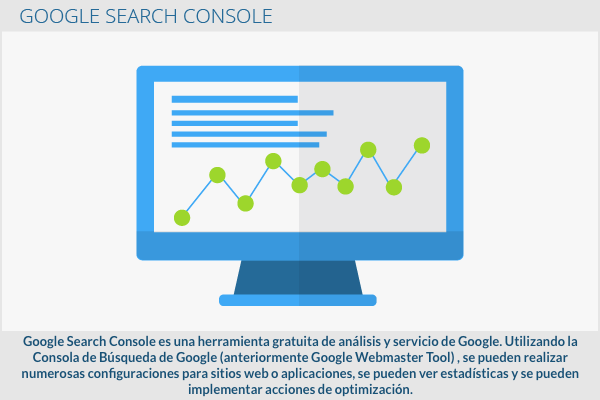Google Search Console is a free service and analysis tool from Google. Using the Google Search Console (formerly Google Webmaster Tool), numerous settings for websites or apps can be made, statistics can be viewed and optimization actions can be taken. At the same time, it warns of the presence of unnatural backlinks or malware, which has been installed on the web. Google Search Console data is not fully public, unlike Alexa data. Metrics from the Google Search Console can be linked to Google Analytics to drive data.

Context
For Google it is very important that websites are solidly programmed and that the number of errors is kept within limits. This intention is not only altruistic. On the one hand, the Mountain View company wants to make sure that its search results show the highest possible quality targets and, on the other, the optimization of the websites is definitely important to maintain a high level of quality of the pages. target for commercial promotion using Google AdWords or Google AdSense publishers' websites.
At the same time, it can be assumed that Google receives additional information about the design and relevant data of the web portal through data management with the Webmaster Tools.
Requirements for use
To use the Google Search Console, you must first register the page in question. A valid Google account is required. After registration, the owner must verify the page. There are four different recommended methods for doing this.
Alternatively, the web page can also be verified through a valid Analytics account, through the provider's domain name, an HTML tag, or the Google Tag Manager. After the verification is complete, the tool displays the relevant data of that web page and its common characteristics can be used.
Features
The Google Search Console contains a large number of functions that can be used for the analysis and optimization of a website. These functions are briefly described below:
- Storing an XML sitemap: All URLs on a website can be transmitted to Google using the XML sitemap. Even though this does not guarantee future indexing, there is a chance that even items on the page that are difficult to access will continue to be crawled. At the same time, you can also set up a sitemap with separate images or a video map. The tool analyzes each map after loading to detect errors.
- robots. If a robot is stored. txt, it can be reviewed with the Google Console. New instructions for the bot can also be tested there.
- Site settings: You can choose your preferred country, as well as information about the desired default domain format (with or without www) and determine the crawl speed (up to two server requests per second). If you don't know the performance of your server, you should let Google do the setup automatically.
- Ignorance of backlinks: One of the most discussed tools on the SEO scene in recent years is the GWT disavow tool. Inbound links can be declared invalid if a webmaster believes that these links are more harmful than beneficial. Many SEOs believe that Google uses the data from this tool to discover link networks. The tool can be found here
- Ignore URL parameters: SEOs and webmasters can use GWT to override individual parameters of a URL. You can set if the parameter influences the content or if it is, for example, a tracking parameter like "utm".
- Removing URLs from the index: An important feature of Google Webmaster Tools is the temporary removal of URLs from the Google index. This is useful when individual subpages are inadvertently listed in the index. This function does not replace exclusive indexing using tags such as noindex.
- Data Highlighter: This feature allows you to mark the relevant positions of a web page so that Google can identify structured information, such as office hours and prices.
Recovered as by the Googlebot: With this tool you can see a web portal like a spider and discover syntax errors. Furthermore it is feasible to render the page absolutely.
- Send URL to Google index: Once a web portal has been retrieved with "Retrieved from Google", it can be sent directly to the Google index and the URLs associated with it. You can index multiple URLs at the same time.
- Structured data control: When a web portal uses microformats or other structured data, it can be verified that a web portal is tagged with the Google Console.
- Rich Cards Control: If a web portal uses Rich Cards, these can be checked with the GSC.
- Check AMP pages: If a web page has been implemented as AMP, the implementation can be controlled with the Google Search Console.
- Check Mobile Compatibility - GSC indicates whether URLs are mobile-friendly.
- hreflang-Test: If a web portal is internationally oriented and has multiple language and country versions, it can be tagged with hreflang. The Google Console can control these tags
- Blocked Resources: Google Search Console shows users when important resources cannot be loaded on a web page or when they prevent Googlebot from indexing.
Statistical tools
Along with the "active" features, the Google Console provides a large database with statistics.
- Control Panel: Webmasters can get an overview of DNS status, crawl errors, search queries, robots.txt validity, and sitemap and URL errors.
- Searches: Like Google Analytics, the console also provides an overview of searches, CTR and clicks, and rankings for individual keywords. These statistics can be downloaded or limited to a specific period. However, this data will only be displayed on the console for 16 months.
- Inbound links- The console provides users with an overview of the inbound links that Google has recorded. Unlike paid backlink tools, GWT doesn't crawl as deep and the backlink listing is usually shorter.
- Internal links: Google provides a useful overview and shows how many internal links there are from specific subpages. This is an important aspect of optimizing a page.
- Indexing status: Shows how a web page was indexed. This metric is very useful for finding possible penalties. The Search Console also shows how many pages of a website have been indexed and which pages have been removed.
- HTML enhancements: Google offers feasible optimization potential for meta descriptions and titles with this tool.
- Crawl error: The Search Console informs users about 404 or Soft 404 errors, both in the desktop version and in the mobile device version.
Google notifications
If you have registered your website in Google Webmaster Tools, you will receive a notification from Google if there are problems with tracking. Google also notifies webmasters if there are problems with the server or for certain software updates (such as WordPress). At the same time, it reports any type of spam or hacking through the security problems function. If Google detects unnatural links or copyright infringements, you can send messages to webmasters using the manual action element.
Other web tools
Originally, the new analytics tools were introduced as beta versions using the old Google Webmaster Tools and could be tested by users. At this time, the Search Console provides links to other tools such as the Ad Ease of Use Report, an email brand checker, or a tool for creating and testing structured data.
SEO benefits
If the keyword status is "not provided", SEOs can use the console as a supplement to Google Analytics. Therefore, specific data on access is provided using keywords. But the tool also has many advantages apart from this. The possible apps can simply be divided into two levels:
- Practical auxiliary tool: the console facilitates the administration of a web portal for Google search. Webmasters do not need to be experts in terms of managing the source code or server. A good example is the option to choose a preferred version of the web (with or without www) with the console. Authorship branding, for example, can be set up with Data Highlighter without any programming knowledge to preserve the ability to display rich snippets.
Comprehensive optimization tool: When saving the XML sitemap, all subpages of a domain will be relayed to Google. Notifications about errors in the sitemap, or about malicious links, and the analysis of meta-information are also useful.
If you always need to get the latest news and tips about Google Search Console, you can check them regularly in Google Webmaster Central. After registering in the Google Search Console, you can also subscribe to receive any new information by email. The alert feature for "unnatural links" shook the SEO scene more than once in 2012 after the Penguin update.
Trivia
Since May 20, 2015, Google's Webmaster Tools are officially called Google Search Console. Once Google got more information from the users of the Webmaster Tools, they discovered that only some of them are simply "webmasters." Google has decided to rename this product to appeal to all users who use the tool, such as small business owners, hobbyists, SEOs, etc.





